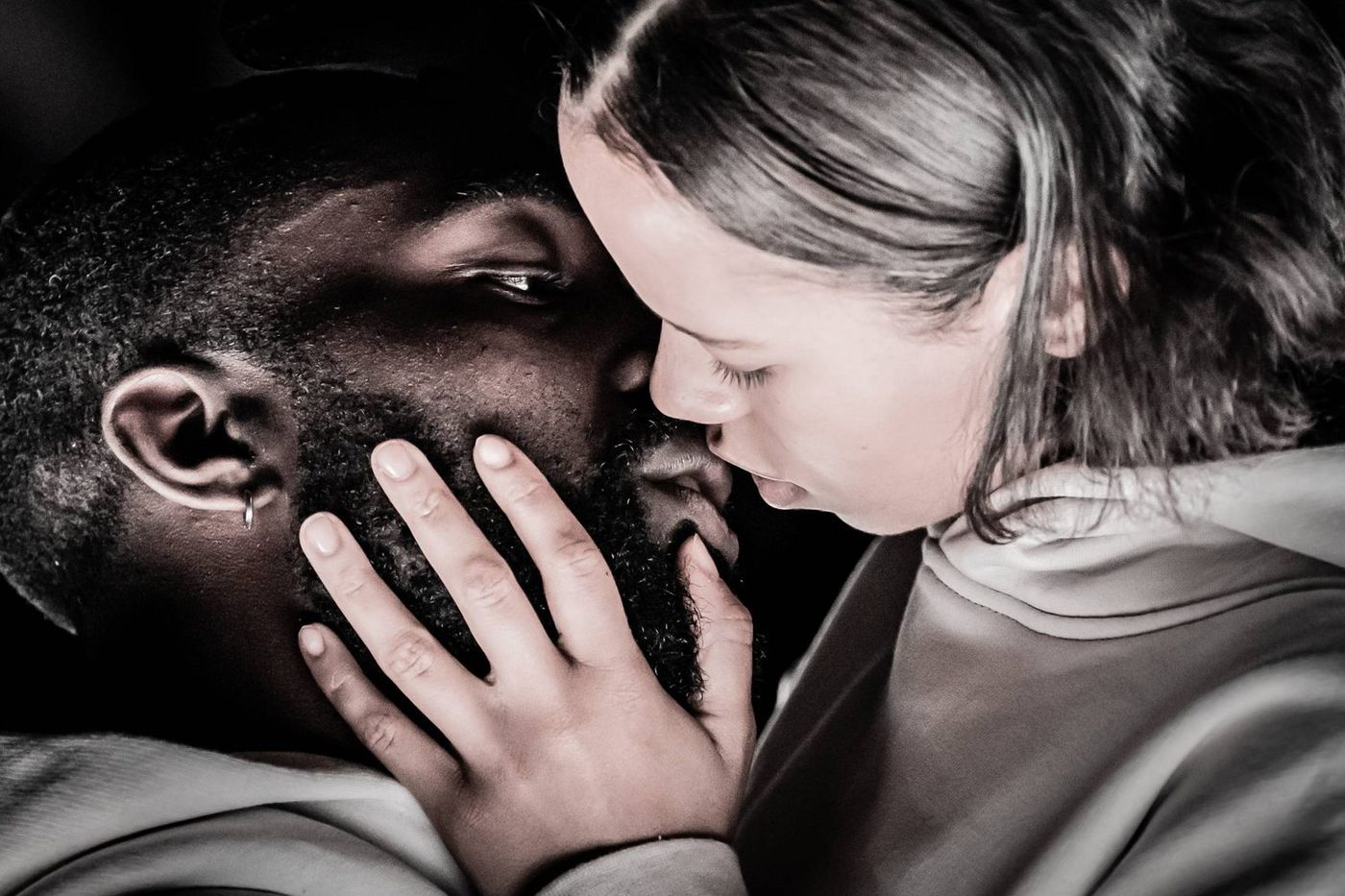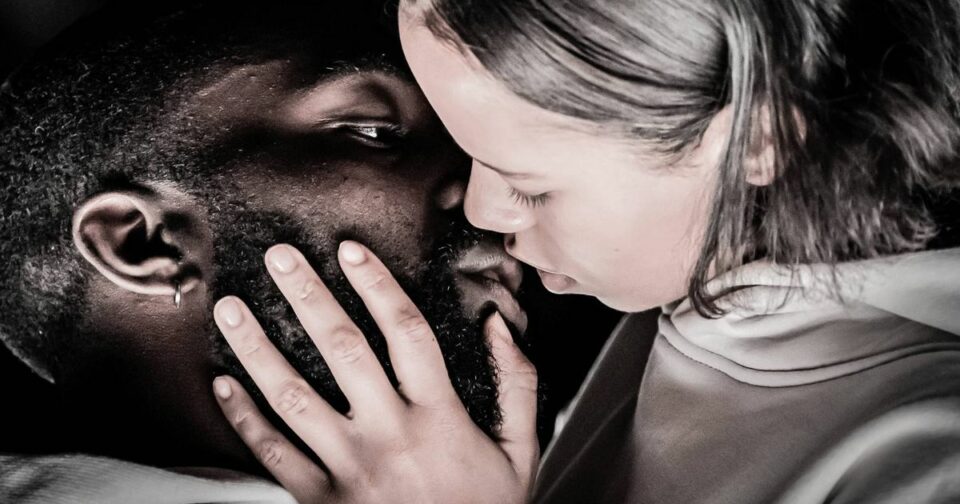The forecast at the Gerald Schoenfeld Theatre calls for rain. Any self-respecting musical of the celebrated 2004 cinematic weepie The Notebook (itself adapted from Nicholas Sparks’s 1996 novel) has got to guarantee literal showers of at least the scattered variety on stage, and this one is also capitalizing on its audience’s emotional precipitation by selling souvenir boxes of tissues in the lobby. But if I had to take bets on how many actual tears The Notebook The Musical manages to jerk — well, I wouldn’t advise anyone to bring a bucket. With prosaic direction and a strangely heavy and sterile aesthetic sense that feels, despite Schele Williams’s presence as a co-director, all too similar to Michael Greif’s other productions this season, as well as a surprisingly beige slate of songs by the folk-pop artist Ingrid Michaelson, the show disappears from memory almost moment to moment. It’s almost enough to make one want to reference the half of the story’s plot that deals with dementia.
Where plot is concerned—if you are, like me, a human being who somehow managed to miss the movie in 2004—here’s the gist. It’s the 1940s in the soda-fountain South and a pair of teenagers named Allie and Noah (played by Regina George and Ken) fall in love. Her snooty parents drive them apart, she doesn’t get his letters, he goes to war, she almost marries someone else, but their love is too powerful (and too wet and wild) to be denied. The rub comes years later, when Regina—sorry, Allie—is no longer able to remember her beloved husband or their lives together, so, every day in their care home, Noah reads her the story of their love from the … it rhymes with “boat hook.”
In normal circumstances I would have warned of spoilers in the above, but The Notebook—in movie form and even more so as a piece of theater—is almost entirely uninvested in surprise. It’s not built around suspense or revelation but around our pretty much immediate understanding of its premise and the continuous increase of our heartache over time. We’re supposed to see everything coming, long for it to come, and revel in how agonizingly bittersweet it is, just as we knew it would be, when it does. Take all this and package it up in musical-from-movie form, and the sentimental anticipation factor increases tenfold. Sure, perhaps not everybody in the theater is here because they remember how good the heartbreak felt in 2004, but that doesn’t change the fact that the engine of the whole machine is nostalgia.
That’s part of what makes it so odd that The Notebook—as reconceived through Bekah Brunstetter’s book, Michaelson’s music and lyrics, and Greif and Williams’s direction—is so aggressively generic. The film wasn’t exactly made up of sharp edges, but it did have its specificities, its “iconic” moments. Yet here a heavy sanding block has still been taken to the material, smoothing the characters into cutouts and the bursts of melody that come out of them into indistinguishable mid-intensity washes of feeling. Michaelson has written some inarguably catchy songs, but none of that snap and verve is on display here: “Time, time, time, time / It never was mine / Mine, mine, mine,” sings older Noah (Dorian Harewood), looking back misty-eyed at the play’s beginning. “But you know what is? / Love, hope, breath, and dreams / As cliché as that seems.” Nay, it is. I know not seems. Sorry, but just pointing to something and winking doesn’t make it go away.
The Notebook’s songs at times barely make lyrical sense. Where the movie uses two sets of actors, the musical deploys three, and when middle Noah (Ryan Vasquez) sings about the house that he’s spent years renovating while pining for the girl he still loves, his sentence structure gets downright dicey: “I built these walls / To bring you home / But all they bring me is more alone.” As middle Allie, Joy Woods has a beautiful voice, but her big number, “My Days” feels like it was taken down from a shelf of cans labeled “General ‘Breaking Free’ Songs.” Not only could it be cut-and-pasted into pretty much any musical without adjustment for circumstance (“I followed my joy, / I followed my heart, / I lived this one wild life, / I ripped it apart”), but it also joins Noah in lyrical territory that borders on satire: “Sometimes I feel / Like I lost my only voice / But then I realize / Only I can choose my choice.”
Meanwhile—while the show’s music has been outstripped by any number of brilliant parodies—its storytelling is bogged down by a passel of questionable choices. The set, by David Zinn and Brett J. Banakis, attempts to locate us metaphorically inside the big, rambling old house that young Noah (a sweet John Cardoza) longs to live in one day with Allie (played in her youngest form by an appealingly spunky Jordan Tyson), but the way in which the directors and designers have envisioned this dream home makes it feel more subterranean than celestial. The woodwork is dark and dour, with black iron railings and a windowless back wall that, when closed, renders the whole space heavy and airless. We do get a stretch of sky when the wall opens up, but Ben Stanton’s lights and Lucy Mackinnon’s projections often paint it in a very specific shade of blue — a harsh, cold primary tone that Greif has favored as the backdrop both to Days of Wine and Roses and Hell’s Kitchen (it’s a defining color in Dear Evan Hansen, too). Zinn and Banakis’s set also shares a similar downstage moat with Days of Wine and Roses — this one made to feel a bit like a coastal dock, where the kid protagonists meet to flirt and splash, and where 30-something Allie and Noah will get doused by the inevitable rainstorm. Practically, the moat works well enough, as does the rain when it finally buckets down, but there’s something about the show’s gestures that registers as both automatic and chilly. This isn’t fertile ground for playfulness, or for romance.
Inside this stuffy box, Brunstetter has adjusted the film’s story in ways that—while they might at first glance seem appropriate to a new moment—feel underexamined. Teen Noah and Allie are Boomers now, and no longer meet in the 1940s but in 1967. The war Noah goes off to is Vietnam, and the home where older Noah reads to his ailing wife (Maryann Plunkett, who’s being pushed to overplay the character’s condition in a way that feels cringily like trauma porn) exists somewhere in our contemporary world. Why the change? Here, young Noah is white and young Allie is Black, and Williams told the Times that the show’s team wanted a context in which an interracial relationship “could take place and could be probable.” Great — except that The Notebook tries to play by two entirely different sets of rules. The choice to change the show’s setting and acknowledge Noah and Allie’s love as interracial implies a world where race does in fact exist; but the show also switches the races of older Allie and Noah in the name of, in Williams’s words, “expansiveness” and “inclusiveness.” There’s a weird race blindness at work in this latter choice—and in the fact that the characters’ races, despite apparently being real to the creators, never matter or bear mentioning on stage—that jangles up against the stated intentions of the story’s re-setting (it also no longer takes place in the South but in a generalized “coastal town in the Mid-Atlantic”). In trying to simultaneously acknowledge and ignore the truth of their actors’ bodies, the show’s creative team has created a pesky dissonance. Perhaps this is why Brunstetter’s book, on the whole, steers clear of specificity. Details are risky; they add both flavor and flaws. Gone is the moment in which young Noah dangles from a Ferris wheel in a mischievous attempt to blackmail Allie into going out with him, or where he convinces her to lie down beside him in the street because she needs to learn to “do what she wants.” No doubt these moments were focus-grouped and deemed a little sexist — how dare he manipulate her by threatening to kill himself! But in stripping Noah of his potentially problematic brazenness, Brunstetter hasn’t replaced it with anything. Now, he’s basically just nice.
There’s a uniquely damp kind of fizzle when a show like The Notebook neither forges into compelling new territory nor even manages to deliver nostalgic satisfaction. But if you’re craving an exploration of the complexities of evolving love—and of the delicate machinery of the brain, where a blown fuse can mean a forgotten life—Lucy Prebble’s The Effect, now at the Shed, is infusing this same stuff with real electricity. Prebble, a seriously sharp writer who’s recently been knocking it out of the park in TV land (I Hate Suzie, Succession), wrote The Effect more than a decade ago, but in Jamie Lloyd’s slick new production, in from the National Theatre in London, the play feels unaged — muscular, troubling, full of the driving, anxious desire to know, and, in its own way, deeply romantic.

Lloyd, too, is a director with a definite and recognizable style: empty space, expensive lighting rig, celebrities. His A Doll’s Houseand his Cyrano—and, less recently, his Betrayal—stripped classics naked and redressed them in leather and chic knitwear. His Broadway-bound Sunset Boulevard revival promises similar fuck-you austerity (I think of him as the bad-boy chef of directors), and The Effect—which unfolds on a dark, raised catwalk-style stage designed by his frequent collaborator Soutra Gilmour, with audience banks on either side and many dollars worth of moving LEDs above—is no exception in the Lloydiverse. Taking your seat while the murky space pulses with electric music, you feel like you’re getting settled for the latest Tom Ford ready-to-wear show. But the trick is that, whether or not you find Lloyd’s scenic containers powerful or repetitive, the acting inside them is usually fire. And, when the director is at his best, the deceptive simplicity of his theatricality reveals the super-solid bone structure of the material at hand. If you’re gonna have a gimmick, it better work, bitch.
Here, it does. Driven by four absolutely dialed-in performances, The Effect unfolds in a series of almost nightmarish flashes. The only objects on stage are two chairs and a white bucket—what it contains is a fantastic reveal—but rather than feeling free on this open stretch of ground, the characters are continually trapped and corralled by Jon Clark’s pulsing, slicing white lights. Isolated in glowing boxes, left motionless in the dark, or pushed this way and that by the hard lines between illumination and shadow, they play out a story that questions the nature and existence of control. Connie (Taylor Russell) and Tristan (Paapa Essiedu) are both participants in a drug trial for a new antidepressant. She’s a smart, nervous psychology student from Canada, living in England and dating an older teacher from her department (“He never taught me,” she tells Tristan with faint defensiveness). He’s a London lad at loose ends with a working class kid’s fuzzy but potent dreams of escape: “You trust me,” he tells Connie, “I’m going to see a lunar rainbow. In Zambia, there are three days a year where the full moon hits this waterfall and refracts the moonlight.”
As Connie and Tristan receive higher and higher dosages of the drug, administered by the dry, observant Dr. Lorna James (Michele Austin, who beautifully implies the perilous depths beneath the character’s professional armor), they become more and more drawn to each other. Soon enough, things are said, curfews are broken, and, with suspiciously coordinated timing, pulse monitors are removed. They’re in love — the wild, giddy, all-consuming kind of love that makes you feel like you “might never sleep again.” Or, is it simply a side effect of the drug? Can their hearts be trusted if everything they’re feeling might be a mere confluence of chemicals in their brains?
What makes Prebble’s play so affecting is the vast existential sweep of its central question. It’s not about a single clinical trial or a single instance of uncertainty: It’s a greater act of wrestling with how much we can ever truly understand about ourselves, with the mystery that refuses to go away no matter how many facts and figures we accrue. Is knowledge “a myth” as Tristan insists, or are we and all that we feel—love, rage, curiosity, joy—reducible to a series of signals and parts, complex, certainly, but ultimately comprehensible? “We are our bodies, our bodies are us… there’s not something more,” says Connie. “We are this three pound lump of jelly,” says Lorna, marveling at the brain. “But,” she falters, “it’s not necessarily me, is it?”
As Dr. James, Austin gives a gorgeously calibrated performance that gradually comes around to reminding us that love isn’t the only, nor even the primary enigma under scrutiny here: What’s at the root of the drugs trial—and, in fact, Lorna herself—is sadness. “I swear we’re gonna look back at this chemical imbalance shit like the four humours all over again,” Lorna fires at her boss, the organizer of the trial and, gallingly, an old flame, Dr. Toby Sealey (Kobna Holdbrook-Smith, whose crushed-granite-and-molasses voice is almost distracting, and not in a bad way). “I don’t think we are depressed, I think we’re right. Shit is depressing. The world’s literally on fire and we’re calling people ill and profiting from it.” Lorna clings to her sorrow as real even as she doubts the veracity of Connie and Tristan’s love. But we’ve watched them flirt and bicker and slowly reveal themselves to each other. We’ve seen Connie’s fearfulness and anxiety and the sense of purposelessness that lies under Tristan’s cheeky, loose-limbed affability. Both Russell and Essiedu give superb performances: There’s something child-like in each of them, a fawn’s stiffness in Russell and a perfectly observed restlessness in Essiedu, who’s all dancing feet and shifting limbs, and as each one softens toward the other, their chemistry seems to deposit into solid form. We can see it in the haze that’s been pumped into the set; we can hear it in the continuous low thrum of George Dennis’s sound design. Suppose it is, in fact, just chemistry — a random byproduct? Does that make it less real? What counts as real—the machinery of the body or the messy, ineffable thing we call a “self”—and who gets to decide?
Prebble suggests that entire fields of study, vast swaths of our efforts and activity as human beings, are, at the root, simply attempts at control — little animal flailings against the great dark. If we can measure something, understand and analyze something, cure something, then we have tamed it. We can put one foot in front of the other because there is such a thing as order, and order is good. But The Effect turns a tender, dispassionate eye on that so feared and villainized shadow, chaos: We may not be able to explain or predict the horrific—a sudden, senseless loss; a brain that forgets everyone it’s ever known, or that bullies and berates itself to the point of despair—but no more can we explain the miraculous. Love, too, is a creature of the unknown.
The Notebook is at the Gerald Schoenfeld Theatre.
The Effect is at the Shed through March 31.
Related
- ‘We Only Ever Talk About It in Terms of What Makes Us Laugh’
- Theater Reviews: The Effect and Dry Powder
Sara Holdren , 2024-03-15 01:46:55
Source link


